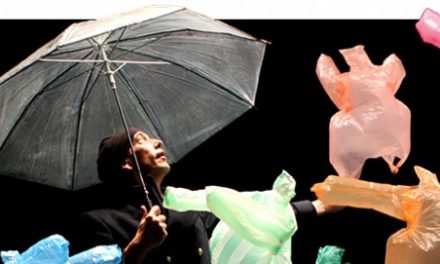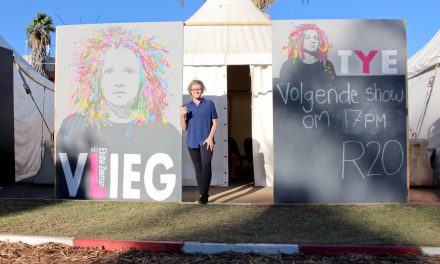Back in 1995, some of the movers and shakers of the domestic theater scene got together at various venues around the capital for an event called the Tokyo Performing Arts Market. The aim was simple: connect up-and-coming Japanese artists to the producers and theater buffs who might be able to support their work.
More than 20 years on, the organizers have changed venues and ditched the name—but kept the acronym. And that is why the Performing Arts Meeting in Yokohama is still referred to as TPAM for short.
The scope has changed, too, with TPAM having grown to include talk sessions and small-scale performances. As attendees exchange name cards and tips on what’s trending in theater, however, contracts can also be agreed on amid the bonhomie.
“Last year, almost 1,000 people—including professional creators, producers, directors, promoters, and critics—participated in TPAM, of whom roughly half were from Japan and half from abroad,” Hiromi Maruoka, director of the event since 2005, tells The Japan Times. “However, if we count the number of total participants, including those who came to watch the performances, we hosted at least 20,000 people.”
Maruoka has every right to brag about her accomplishments. She has worked throughout her career to channel performing arts both into and out of Japan, including in her role as president of the Japan Center, Pacific Basin Arts Communication (PARC), which works to promote Japanese culture abroad and counts TPAM among its successes.
She points out that many similar events to TPAM, such as the annual Australian Performing Arts Market in Brisbane, attract overseas buyers, promoters, and producers by paying for their transport and hotel costs. In contrast to those, however, she says that, though the quasi-governmental Japan Foundation may help first-timers from abroad with their costs, the people who take part in TPAM need to fund themselves. The fact that many participants pay out of their own pockets means a lot to Maruoka.
“That’s why it’s engraved on my heart to uphold TPAM’s mission to introduce the latest trends in contemporary performing arts and create a communication platform for cutting-edge artists and producers,” she says.
Three years ago, TPAM made two key changes that Maruoka believes is the reason the event has inspired such loyalty. The first shift was a move to expand its focus on domestic artists to include a pan-Asian approach.
“Arts markets in South Korea, Singapore, China and Australia mainly promote their own countries’ programs, but I think that inward-looking approach results in decreasing returns,” Maruoka says. “So, although TPAM certainly supports our domestic theater business, it also actively showcases a range of programs from other Asian countries in order to offer more choice. This results in a better gauge of trends for people making a one-stop trip here whether they’re coming from this region or beyond. I think that’s important in order to convey the bigger picture and compete with those overwhelming Western rivals who used to look down on Asian theaters as second tier.
“And of course it means we can ensure a higher-quality program for our audiences, who get the opportunity to watch the productions of top-class Asian theaters.”
As for the other key change TPAM made in 2015, Maruoka says that the event decided to no longer focus solely on young, promising artists, and allow established artists to take part as well.
“In order to step up to the next level of the international market, we started to program the best in Asia to show the world,” she says, referring to a strategy she credits to Singaporean producer Tang Fu Kuen who joined TPAM as its program director for a three-year stint from 2015.
The two moves to expand are paying off, according to Maruoka, who says that recent TPAM programs have already attracted foreign buyers or have launched international tours. One such work, a projection performance titled Fever Room, was in the main program at last year’s TPAM and has since toured several Asian countries. The piece is the debut theatrical work by Thai filmmaker Apichatpong Weerasethakul, winner of the Palme d’Or at the 2010 Cannes Film Festival for Uncle Boonmee Who Can Recall His Past Lives.
When looking at possible standouts from this year’s event, Maruoka lights up before listing off a roster of pieces set to show at TPAM and TPAM Fringe, an offshoot event that was launched last year and which focuses on up-and-coming Japanese theater companies and artists—much like the original event did.
“Around the world, more and more film artists and visual artists are crossing genre boundaries and creating new types of performing arts pieces, and TPAM 2018 is focused on these as opposed to more conventional plays or musicals,” Maruoka says.
“As a result, the only so-called straight play is BankART Studio NYK Kawamata Hall, a solo performance by a South Korean actress that tackles the banality of her everyday life. Most of the works are more like talks, symposiums, concerts, or exhibitions, with many encouraging audience participation.”
One such example of these “new” types of performances is Singaporean visual artist Ho Tzu Nyen’s automated shadow-picture work One Or Several Tigers, which uses projected images and puppets, but no human actors.
“This work explores the history of coexistence between tigers and humans and colonization in Singapore, so it could easily be categorized as visual art,” Maruoka says, adding that she believes the “very aesthetic” 35-minute filmic piece also features great music and is a marvelous cross-genre theater work.
The director then mentions Internship, by internationally acclaimed artist Tetsuya Umeda, which premiered in Gwangju, South Korea, in 2016, and will be presented by TPAM at the Kanagawa Arts Theater in Yokohama. In this work, Umeda stages a concert-style performance created from actual noises made in the theater as people move heavy machines, build structures, and work with chains while Umeda operates the theater’s sound systems, lighting, and overhead spotlight gantries.
Apart from the productions, the event also features the TPAM Exchange, which is open to anyone and this year offers a range of nearly 150 programs that include a reception party, symposiums, and networking opportunities.
The Exchange also includes a group meeting component that allows anyone who pays a small registration fee to host a gathering in a venue provided by TPAM. The one condition is that people who attend the meeting need to be able to get in free of charge. Among the wide range of topics slated for this year so far are advice on how best to apply for subsidies, crowdfunding, and a host of personal projects and performances.
Finally, with regards to the nitty-gritty of running the event, Maruoka says she is grateful that its government funding has gone up since 2015, in line with efforts to prepare Japan’s cultural scene for the global scrutiny that the 2020 Tokyo Olympics are sure to bring. However, to ensure its healthy future beyond the games, she says, “We must strive to get people to understand our unique contribution to the performing arts world so we can sell more tickets and attract more sponsors.”
As it is, with many programs providing English information and subtitles, and many free or with low ticket prices, it’s hard to see TPAM having anything but a healthy future.
This article first appeared on The Japan Times on February 8, 2018, and has been reposted with permission.
This post was written by the author in their personal capacity.The opinions expressed in this article are the author’s own and do not reflect the view of The Theatre Times, their staff or collaborators.
This post was written by Nobuko Tanaka.
The views expressed here belong to the author and do not necessarily reflect our views and opinions.


















